SEELOW HEIGHTS NEXT-TO-LAST NAIL IN HITLER’S COFFIN
Seelow Heights, Germany • April 16, 1945
On this date in 1945 the Allies called off their strategic bombing campaign against Nazi Germany because most targets were already in Allied hands or, like the Reich capital, Berlin, would be soon. So on the day the aerial campaign stopped the Red Army unleashed a battle to capture the Seelow Heights (April 16–19, 1945), 40 miles/64 kilometers east of Berlin. The Seelow escarpment formed the eastern edge of a wide plateau just over 150 feet/46 meters above the Oder River floodplain, the Oderbruch. At this time of year the Oderbruch, between 6 and 10 miles/9.6 and 16 kilometers wide, was saturated with water due to spring melt abetted by released water from an upstream swamp. Nevertheless, the Red Army established a strong presence on the soggy plain.
The situation on Germany’s Eastern Front at the top of April 1945 was grim. The Wehrmacht (German armed forces) had paid dearly for Adolf Hitler’s folly of invading the Soviet Union in the summer of 1941 (Operation Barbarossa). It had suffered staggering losses in men and equipment after countless retreats and rearguard actions following the Battle of Stalingrad (late August 1942 to the end of January 1943), Kursk (July 1943), and Leningrad (1941 to January 1944). By contrast, the Red Army boasted at the outset of 1945 that it had cleared Axis forces out of Mother Russia, was clearing the enemy from East Prussia and Germany’s eastern neighbor, Poland, and was at the moment invading the German heartland as it mopped up pockets of Germans fighting desperately in a general retreat toward the Oder and Neisse rivers.
After breaching the middle Oder River “moat” and building a bridgehead on its west bank, Marshal Georgy Zhukov’s army group, the First Belorussian Front, stood before the Seelow Heights, the so-called “Gates of Berlin.” Under Zhukov’s command were 2 Soviet armies of 1,000,000 men, nearly 17,000 field guns, mortars, and Katyusha truck-mounted rocket launchers, and 3,059 tanks. Facing Zhukov’s armies were 112,143 German men at arms: Gen. Theodor Busse’s Ninth Army, cobbled from untrained Luftwaffe ground units, sailors, guard and police battalions and trainees, and the Volkssturm, itself a motley collection of mostly untested and poorly equipped boy soldiers and old men; and Gen. Helmuth Weidling’s 15,000-strong LVI Panzer Corps, which was assigned to Busse’s Ninth Army. Between Busse and Weidling the German defenders had 2,625 self-propelled guns, regular artillery pieces, and antiaircraft guns and 587 tanks, 55 of which were in repair and another 20 in transit.
Soviet leader Joseph Stalin chose April 16 as the start date for his Operation Berlin, with the capture of the German capital set for Lenin’s birthday, April 22. By dusk on Day 1 the Soviets had managed to clear German forward positions on the floodplain. On Day 2 a First Belorussian army, Lt. Gen. Vasily Chuikov’s 8th Guards, gained the all-important escarpment at terrible costs, overrunning the enemy’s left flank and breaching his lines everywhere. Day 3 witnessed the Soviets exploiting their upper hand as German defenses disintegrated.
Day 4 was a day of reckoning. On April 19, 1945, the First Belorussian Front bludgeoned its way through the third and last defensive line on Seelow Heights. Now the “Gates of Berlin” were busted wide open. By April 23 Hitler’s capital was fully encircled and the Battle of Berlin entered its terminal phase. In 7 days Hitler would be a suicide and 7 days after that the once unbeatable Wehrmacht would sign in Reims, France, the first of 2 unconditional surrender documents. Stalin twisted his enemy’s nose by insisting on a second and grander surrender ceremony amid Berlin’s rubble on May 8, 1945, Victory in Europe (VJ) day. German citizens remember that date as “Stunde Null” (Zero Hour), the moment when the historical slate was wiped clean and everything started fresh and new again, untainted by the past.
Battle of Seelow Heights, April 16–19, 1945
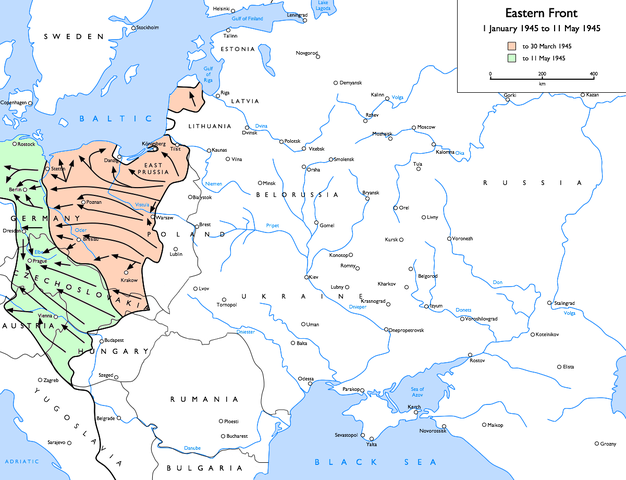 |
Above: Map of the Eastern Front, January 1 to March 31 (colored coral) and April 1 to May 11, 1945 (colored green). Against overwhelming odds, German forces concentrated at the Seelow Heights (3 arrows down in the green area of the map) in a last-ditch effort to block the Red Army’s advance on Berlin. The 4‑day Battle of the Seelow Heights (German, Schlacht um die Seelower Hoehen) is often incorporated into the Battle of the Oder-Neisse (April 1945). The site of some of the most bitter fighting in the overall Oder-Neisse battle, Seelow Heights protected a direct route to Berlin, but the location was only one of dozens of crossing points along the 2 rivers where the Soviets attacked. The Soviet victory at Seelow Heights fed into the opening phase of the Battle in Berlin (aka the Fall of Berlin), April 23 to May 2, 1945, which was the last and most consequential battle of the European War.
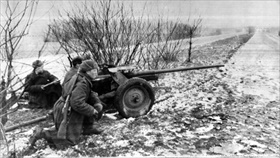 | 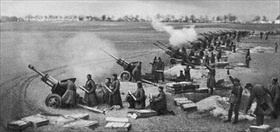 |
Left: As the Red Army in Poland approached the German heartland east of the Oder and Neisse rivers, Soviet artillerymen sometimes paused and deployed their weapons against pockets of German resistance, which desperately tried to stem the Soviet juggernaut to no avail.
![]()
Right: Soviet artillery bombard German positions during the Battle for the Seelow Heights, April 16–19, 1945. The battle to break through the so-called “Gates to Berlin” and capture the ultimate war prize—the cultic heart of Nazism—days after Stalin launched his Berlin offensive cost the Soviets about 30,000–33,000 lives (a more credible estimate is 70,000 lives), 18,000 more than the Germans reputably lost. Despite inspired and fierce resistance, German troops were compelled to fall back, leaving chaotic scenes of devastation in their flight to save themselves. Within 2 weeks of the Soviet breakthrough at Seelow Heights, Hitler took his own life and that of his wife in the Fuehrerbunker of his smashed Thousand Year Reich. Ironically, it was left to Gen. Weidling, since April 25 commander of “Fortress Berlin,” to surrender the city’s shattered remains to his Seelow Heights’ opponent, Soviet Lt. Gen. Chuikov, on May 2, 1945. On May 7 and 8, the German high command signed surrender documents, bringing the war in Europe to an official conclusion.
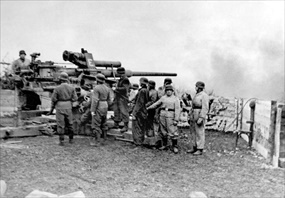 | 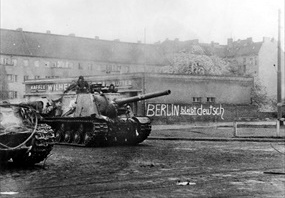 |
Left: Fighting back, German Brandenburger commando troops fire a German 88 mm antiaircraft gun in the tank-killer mode. The gun crew takes aim at Red Army armor and troops on a bridge over the Oder River as they approach the Seelow Heights, a fiercely contested set of fortifications east of Berlin. Once the fortifications fell, basically nothing could stop Zhukov’s First Belorussian Front and Marshal Ivan Konev’s First Ukrainian Front from taking the Reich capital.
Right: After the Battle of Berlin ended on May 2, 1945, Soviet tanks began patrolling the streets of a pacified, eerily quiet Berlin, home to 2 million shell-shocked, weary, and desperate citizens who were slowly emerging from their bomb-ravaged cellars, attics, and other hiding places. An estimated 100,000–125,000 Berliners perished in the battle, 20,000 from heart attacks, 6,000 from suicide. The wall graffiti in the background, likely scrawled by a die-hard SS (Schutzstaffel) man days earlier, reads: “Berlin will remain German” (BERLIN bleibt deutsch). Appended to one such graffiti a smart-alecky Soviet trooper wrote: “But I’m already here in Berlin, [signed] Sidorov.”
Battle of Seelow Heights, April 16–19, 1945
![]()

 History buffs, there is good news! The Daily Chronicles of World War II is now available as an ebook for $4.99 on Amazon.com. Containing a year’s worth of dated entries from this website, the ebook brings the story of this tumultuous era to life in a compelling, authoritative, and succinct manner. Featuring inventive navigation aids, the ebook enables readers to instantly move forward or backward by month and date to different dated entries. Simple and elegant! Click
History buffs, there is good news! The Daily Chronicles of World War II is now available as an ebook for $4.99 on Amazon.com. Containing a year’s worth of dated entries from this website, the ebook brings the story of this tumultuous era to life in a compelling, authoritative, and succinct manner. Featuring inventive navigation aids, the ebook enables readers to instantly move forward or backward by month and date to different dated entries. Simple and elegant! Click 











